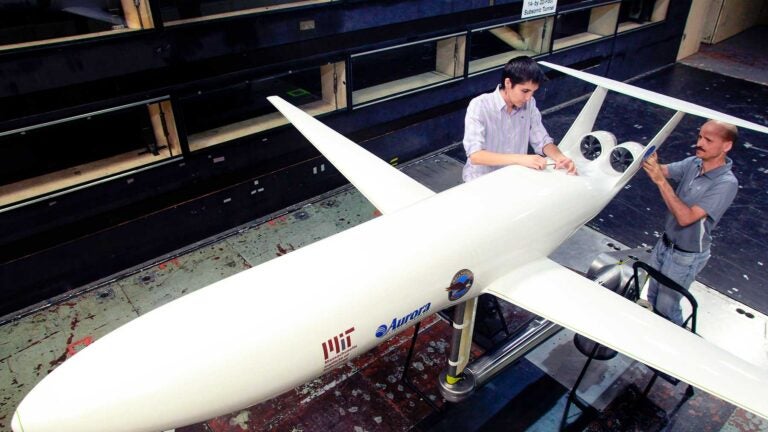
USC Assistant Professor Alejandra Uranga and D8 lead designer Mark Drela work on a wind tunnel model in 2013. (Photo/Dave Bowman, NASA)
USC engineers test planes for NASA that could reduce fuel consumption
The Trojan team aims to meet environmental goal and lower emissions within the next 20 years
In 2008, NASA asked researchers to develop new aircraft designs that meet ambitious energy and environmental goals.
USC’s Alejandra Uranga led one such team in the development and testing of a new commercial aircraft that can reduce fuel consumption, and in turn emissions, by as much as 66 percent within the next two decades.
The demand for air transportation is going up by roughly 5 percent each year.
Alejandra Uranga
“The demand for air transportation is going up by roughly 5 percent each year,” said Uranga, who joined the project as the technology lead in 2010 when she was a research engineer at the Massachusetts Institute of Technology before coming to USC in 2016. “Air transportation only accounts for about 2 percent of the global emissions, but its share is growing and everything else is polluting less and less. Therefore, there is more and more pressure for aviation to become environmentally friendly.”
Uranga and her team modified the existing design of a 737-type aircraft by integrating the structure of the airplane and the propulsion system — relocating the engines from under the wings to on top of the rear of the fuselage. Instead of pushing the air out of the way, similar to how a boat creates a wake, this design, named the D8, pulls the surrounding air into the engines and uses it to propel the plane forward with significantly higher efficiency than with conventional engine placement. This method, known as boundary layer ingestion, is known to reduce vehicle fuel burn and has been applied to torpedoes and submarines, but never realized for airplanes. It is responsible for a big part of the performance benefits of the D8.
Using the 14-by-22-foot wind tunnel at NASA’s Langley Research Center, the researchers tested a model of the D8 aircraft concept, proving that a 20 percent fuel savings through boundary layer ingestion is possible. The tests provide a proof-of-concept for boundary layer ingestion for commercial aircraft.
“Another characteristic of this airplane is that it flies slower than other comparable airplanes. The question we answered in the last year was what are the trade-offs? How much does it cost you to fly fast?” said Uranga, a Gabilan Assistant Professor in the Department of Aerospace and Mechanical Engineering. “We found if you lower the speed from Mach 0.78 to 0.72, you save about 7 percent fuel. So now it’s up to economics to decide whether slowing down is worth it, but it will make more and more sense if fuel prices increase.”
A slight modification
A big advantage of their design is that it resembles existing aircraft, consisting of conventional wings and just a somewhat modified fuselage. The design could be viable for aircraft manufacturing companies while reducing the risk associated with the development of an entirely different airplane.
“It takes around 20 years from saying, ‘I want to have a new airplane,’ until it comes out and an airline can buy it,” Uranga said. “We as academics can work on things that are too risky and bring them to a more feasible level. Then industry can take it on and make the next big airplane. It’s still going to take 10 to 20 years to create it, but at least they know that they are betting on something that will work.”
Collaborating with industry and other partners, rather than purely staying within academia, is one of Uranga’s main themes for her research. By doing so, she is able to take her work a step closer to being adopted by airline companies.
Uranga and her team collaborated on the research with MIT, Aurora Flight Sciences, Pratt & Whitney, United Technologies Research Center and the University of Michigan.
“The goal is for this to happen — for an airliner to use boundary layer ingesting engines,” she said. “To make a big impact on something, sometimes if you work more with industry and with the people who are actually building these things, then there’s a higher chance that you will help something improve.”
